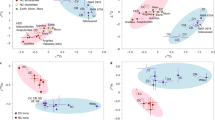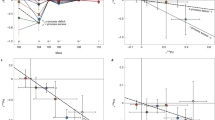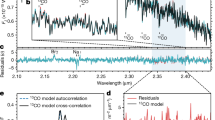Abstract
The abundances of elements and their isotopes in our Galaxy show wide variations, reflecting different nucleosynthetic processes in stars and the effects of Galactic evolution1. These variations contrast with the uniformity of stable isotope abundances for many elements in the Solar System2,3, which implies that processes efficiently homogenized dust and gas from different stellar sources within the young solar nebula. However, isotopic heterogeneity has been recognized on the subcentimetre scale in primitive meteorites4,5, indicating that these preserve a compositional memory of their stellar sources. Small differences in the abundance of stable molybdenum isotopes in bulk rocks of some primitive6,7,8 and differentiated7,9 meteorites, relative to terrestrial Mo, suggest large-scale Mo isotopic heterogeneity between some inner Solar System bodies, which implies physical conditions that did not permit efficient mixing of gas and dust. Here we report Mo isotopic data for bulk samples of primitive and differentiated meteorites that show no resolvable deviations from terrestrial Mo. This suggests efficient mixing of gas and dust in the solar nebula at least to 3 au from the Sun, possibly induced by magnetohydrodynamic instabilities10. These mixing processes must have occurred before isotopic fractionation of gas-phase elements and volatility-controlled chemical fractionations were established.
This is a preview of subscription content, access via your institution
Access options
Subscribe to this journal
Receive 51 print issues and online access
$199.00 per year
only $3.90 per issue
Buy this article
- Purchase on Springer Link
- Instant access to full article PDF
Prices may be subject to local taxes which are calculated during checkout


Similar content being viewed by others
References
Wallerstein, G. et al. Synthesis of the elements in stars: forty years of progress. Rev. Mod. Phys. 69, 995–1084 (1997)
Suess, H. E. & Urey, H. C. Abundances of the elements. Rev. Mod. Phys. 28, 53–74 (1956)
Anders, E. & Grevesse, N. Abundances of the elements: Meteoritic and solar. Geochim. Cosmochim. Acta 53, 197–214 (1989)
Anders, E. & Zinner, E. Interstellar grains in primitive meteorites: Diamond, silicon carbide, and graphite. Meteoritics 28, 490–514 (1993)
Harper, C. L. in Nuclei in the Cosmos (eds Käppeler, F. & Wisshak, K.) 113–126 (IOP Publishing, Bristol, 1993)
Yin, Q., Jacobsen, S. B. & Yamashita, K. Diverse supernova sources of pre-solar material inferred from molybdenum isotopes in meteorites. Nature 415, 881–883 (2002)
Dauphas, N., Marty, B. & Reisberg, L. Molybdenum evidence for inherited planetary scale isotope heterogeneity of the protosolar nebula. Astrophys. J. 565, 640–644 (2002)
Dauphas, N., Marty, B. & Reisberg, L. Molybdenum nucleosynthetic dichotomy revealed in primitive meteorites. Astrophys. J. 569, L139–L142 (2002)
Qi Lu & Masuda, A. in Origin of Elements in the Solar System (ed. Manuel, O.) 385–400 (Kluwer/Plenum, New York, 2000)
Stone, J. M., Gammie, C. F., Balbus, S. A. & Hawley, J. F. in Protostars and Planets IV (eds Mannings, V., Boss, A. P. & Russell, S. S.) 589–611 (Univ. Arizona Press, Tucson, 2000)
Clayton, R. N. Oxygen isotopes in meteorites. Annu. Rev. Earth Planet. Sci. 21, 115–149 (1993)
Lewis, R. S., Anders, E., Wright, I. P., Norris, S. J. & Pillinger, C. T. Isotopically anomalous nitrogen in primitive meteorites. Nature 305, 767–771 (1983)
Thiemens, M. H. & Heidenreich, J. E. III The mass-independent fractionation of oxygen: A novel isotope effect and its possible cosmochemical implications. Science 219, 1073–1075 (1983)
Clayton, R. N. Self-shielding in the solar nebula. Nature 415, 860–861 (2002)
Lee, T., Shu, F. H., Shang, H., Glassgold, A. E. & Rehm, K. E. Protostellar cosmic rays and extinct radioactivities in meteorites. Astrophys. J. 506, 898–912 (1998)
Shukolyukov, A. & Lugmair, G. W. Manganese-chromium isotope systematics of Ivuna, Kainsaz and other carbonaceous chondrites. Lunar Planet. Sci. XXXIV, 1279 (2003)
Niederer, F. R., Papanastassiou, D. A. & Wasserburg, G. J. Absolute isotopic abundances of Ti in meteorites. Geochim. Cosmochim. Acta 49, 835–851 (1985)
Dauphas, N., Marty, B. & Reisberg, L. Inference on terrestrial genesis from molybdenum isotope systematics. Geophys. Res. Lett. 29, 1084 (2002)
Becker, H. & Walker, R. J. Ruthenium isotopic composition of terrestrial materials, iron meteorites and chondrites. Lunar Planet. Sci. XXXIII, 1018 (2002)
Becker, H. & Walker, R. J. In search of extant Tc in the early solar system: 98Ru and 99Ru abundances in iron meteorites and chondrites. Chem. Geol. 196, 43–56 (2003)
Schönbächler, M., Lee, D.-C., Halliday, A. N. & Rehkämper, M. Uniformity of zirconium isotopic compositions in the inner solar system. Lunar Planet. Sci. XXXIII, 1283 (2002)
Pernicka, E. & Wasson, J. T. Ru, Re, Os, Pt and Au in iron meteorites. Geochim. Cosmochim. Acta 51, 1717–1726 (1987)
Becker, H., Morgan, J. W., Walker, R. J., MacPherson, G. J. & Grossman, J. N. Rhenium-osmium systematics of calcium-aluminium-rich inclusions in carbonaceous chondrites. Geochim. Cosmochim. Acta 65, 3379–3390 (2001)
McCulloch, M. T. & Wasserburg, G. J. Barium and neodymium isotopic anomalies in the Allende meteorite. Astrophys. J. 220, L15–L19 (1978)
Shu, F. H., Shang, H. & Lee, T. Toward an astrophysical theory of chondrites. Science 271, 1545–1552 (1996)
Nier, A. O. A redetermination of the relative abundances of the isotopes of carbon, nitrogen, oxygen, argon and potassium. Phys. Rev. 77, 789–793 (1950)
Qi Lu & Masuda, A. The isotopic composition and atomic weight of molybdenum. Int. J. Mass Spectrom. Ion Proc. 130, 65–72 (1994)
Russell, W. A., Papanastassiou, D. A. & Tombrello, T. A. Ca isotope fractionation on the Earth and other solar system materials. Geochim. Cosmochim. Acta 42, 1075–1090 (1978)
Acknowledgements
We thank R. Clarke and G. MacPherson for providing the meteorite samples, N. Dauphas, H. Palme, D. Papanastassiou, A. Pietruszka and Q. Yin for discussions, and P. Tomascak for comments on the manuscript and technical support in the laboratory. Comments by S. Jacobsen have improved the presentation of various issues in this manuscript.
Author information
Authors and Affiliations
Corresponding author
Ethics declarations
Competing interests
The authors declare that they have no competing financial interests.
Rights and permissions
About this article
Cite this article
Becker, H., Walker, R. Efficient mixing of the solar nebula from uniform Mo isotopic composition of meteorites. Nature 425, 152–155 (2003). https://doi.org/10.1038/nature01975
Received:
Accepted:
Issue Date:
DOI: https://doi.org/10.1038/nature01975
This article is cited by
-
Inside the cosmic blender
Nature (2003)
Comments
By submitting a comment you agree to abide by our Terms and Community Guidelines. If you find something abusive or that does not comply with our terms or guidelines please flag it as inappropriate.



